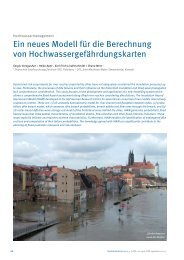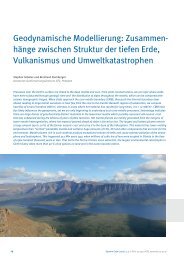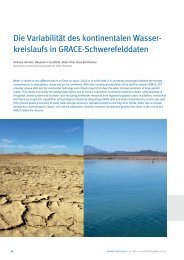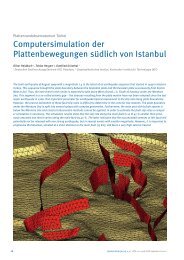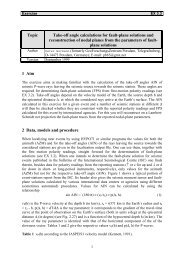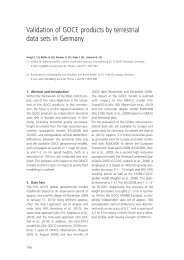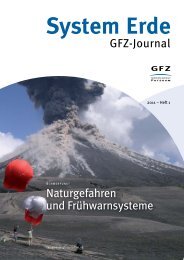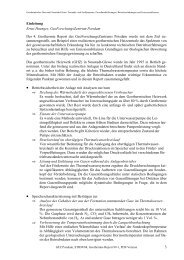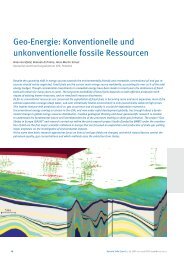2 Seismic Wave Propagation and Earth models
2 Seismic Wave Propagation and Earth models
2 Seismic Wave Propagation and Earth models
You also want an ePaper? Increase the reach of your titles
YUMPU automatically turns print PDFs into web optimized ePapers that Google loves.
2. <strong>Seismic</strong> <strong>Wave</strong> <strong>Propagation</strong> <strong>and</strong> <strong>Earth</strong> <strong>models</strong><br />
Fig. 2.32 Schematic local travel-time curves (time t over distance x from the source) for a<br />
horizontal two-layer model with constant layer velocities v1 <strong>and</strong> v2, layer thickness h1 <strong>and</strong> h2<br />
over a half-space with velocity v3. Other abbreviations st<strong>and</strong> for: t 1 ic <strong>and</strong> t 2 ic – intercept times<br />
at x = 0 of the extrapolated travel-time curves for the “head-waves”, which travel with v2<br />
along the intermediate discontinuity between the layers 1 <strong>and</strong> 2 <strong>and</strong> with v3 along the<br />
discontinuity between layer 2 <strong>and</strong> the half-space, respectively. x 1 cr <strong>and</strong> x 2 cr mark the distances<br />
from the source at which the critically reflected rays from the bottom of the first <strong>and</strong> the<br />
second layer, respectively, return to the surface. Beyond x 1 co <strong>and</strong> x 2 co the head-waves from the<br />
bottom of the first <strong>and</strong> the second layer, respectively, become the first arriving waves (xco -<br />
crossover distance) Rays <strong>and</strong> their corresponding travel-time curves are shown in the same<br />
color. The full red (violet) travel-time curve relates to the supercritical reflections (i > icr)<br />
from the intermediate (lower) discontinuity while the dotted red (violet) travel-time curve<br />
refers to the respective pre-critical (i < icr) steep angle reflections.<br />
In the case of horizontal layering as in Fig. 2.32 the layer <strong>and</strong> half-space velocities can be<br />
determined from the gradients dt/dx of the yellow, green <strong>and</strong> blue travel-time curves which<br />
correspond to the inverse of the respective layer velocities. When determining additionally the<br />
related intercept times t 1 ic <strong>and</strong> t 2 ic by extrapolating the green <strong>and</strong> blue curves, or with help of<br />
the crossover distances x 1 co <strong>and</strong> x 2 co, then one can also determine the layer thickness h1 <strong>and</strong> h2<br />
from the following relationships:<br />
h1 = 0.5 x 1 co<br />
v1<br />
+ v<br />
v + v<br />
1<br />
2<br />
2<br />
=<br />
0.<br />
5<br />
t<br />
1<br />
ic<br />
v ⋅v<br />
v<br />
1<br />
2<br />
2<br />
2<br />
− v<br />
2<br />
1<br />
<strong>and</strong> h2<br />
34<br />
t<br />
− 2 h<br />
v<br />
− v<br />
(v ⋅v<br />
)<br />
2<br />
2 2<br />
−1<br />
=<br />
ic<br />
2<br />
1 3 1 1 2<br />
2 2<br />
−1<br />
v 3 − v 2 ⋅(v<br />
2 ⋅v<br />
3 )<br />
. (2.18)<br />
For the calculation of crossover distances for a simple one-layer model as a function of layer<br />
thickness <strong>and</strong> velocities see Equation (6) in IS 11.1.<br />
In the case where the layer discontinuities are tilted, the observation of travel-times in only<br />
one direction away from the seismic source will allow neither the determination of the proper<br />
sub-layer velocity nor the differences in layer thickness. As can be seen from Fig. 2.33, the<br />
intercept times, the cross-over distances <strong>and</strong> the apparent horizontal velocities for the<br />
critically refracted head-waves differ when observed down-dip or up-dip from the source<br />
although their total travel times to a given distance from the source remain constant.



